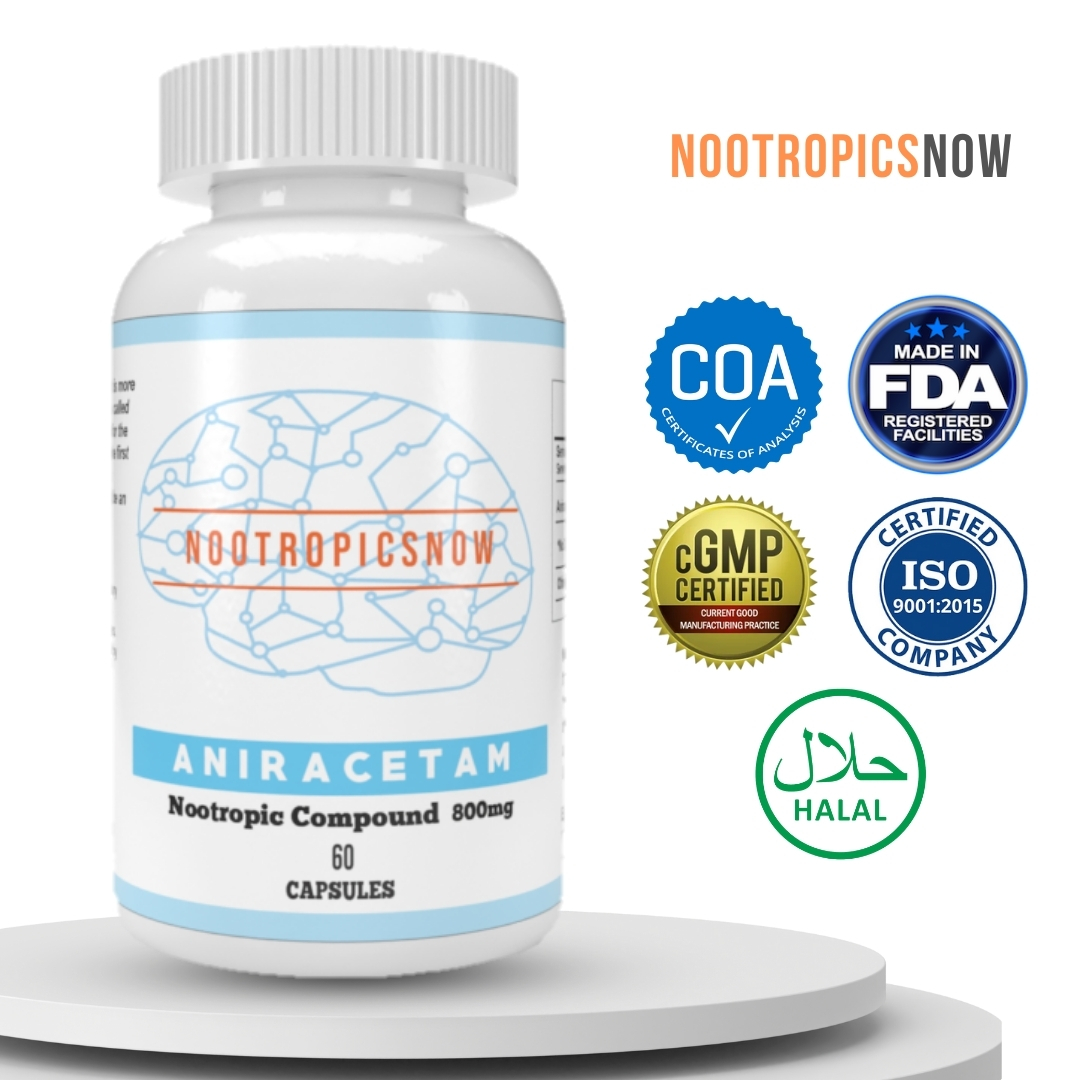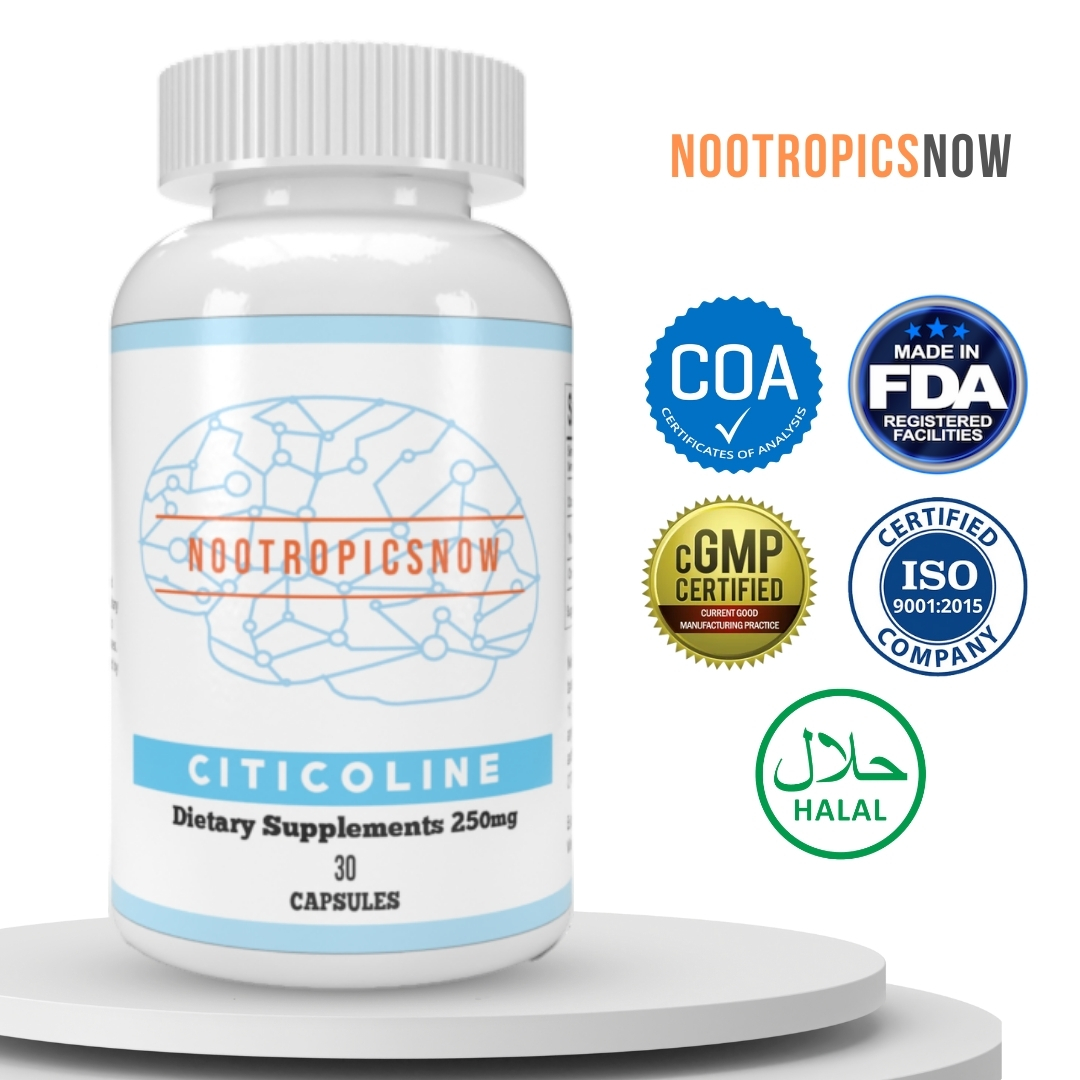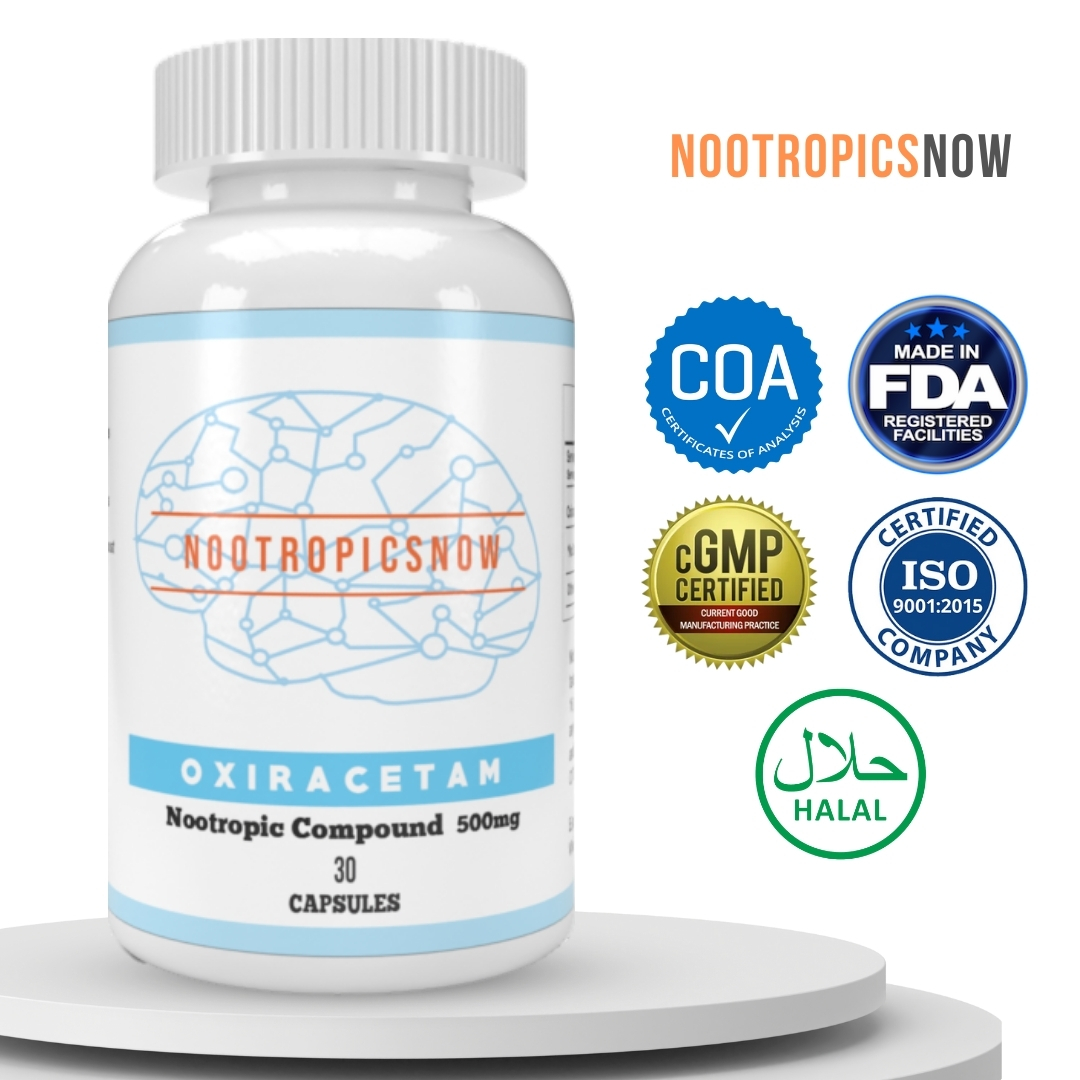Aniracetam: Benefits, Uses & Side Effects

Aniracetam: Unveiling the Potential of this Nootropic
Aniracetam, a popular synthetic nootropic, has garnered significant attention for its purported cognitive-enhancing properties. As a member of the racetam family, it shares structural similarities with other well-known nootropics, like piracetam. However, aniracetam is distinguished by its enhanced potency and unique effects on cognitive function. Let’s delve into the details of aniracetam, exploring its mechanisms, benefits, side effects, and how to use it effectively.
Understanding Aniracetam: Chemical Properties and Origins
Aniracetam, chemically known as 1-p-anisoyl-2-pyrrolidinone, is an ampakine nootropic. This means it primarily influences cognitive function by modulating the AMPA receptors in the brain. AMPA receptors play a crucial role in synaptic plasticity, which is essential for learning and memory.
Developed by Hoffmann-La Roche in the 1970s, aniracetam has been studied for its potential to improve cognitive function, particularly in individuals with age-related cognitive decline or other neurological conditions. Despite its relatively long history, the precise mechanisms of aniracetam are still being investigated. Consequently, its use and availability vary across different countries, with some regulating it more strictly than others.
Mechanisms of Action: How Aniracetam Impacts the Brain
Aniracetam’s primary mechanism involves modulating the AMPA receptors, as mentioned earlier. However, it also influences other neurotransmitter systems, contributing to its broader cognitive effects.
These multifaceted mechanisms of action contribute to aniracetam’s potential benefits, impacting various aspects of cognitive function.
Cognitive Benefits: What Can Aniracetam Do for You?
Aniracetam is lauded for a range of cognitive benefits, making it a popular choice among nootropics enthusiasts. These benefits include:
However, it is crucial to note that individual experiences can vary, and not everyone will experience all these benefits. Dosage, individual physiology, and lifestyle factors can all influence the effects of aniracetam.
Aniracetam Dosage: Finding the Right Amount
Determining the optimal dosage of aniracetam can be a process of experimentation, as individual responses vary. However, some general guidelines can help you find the right amount:
The ideal dosage range for most users falls between 750mg and 1500mg per day. However, some individuals may find that lower doses are sufficient, while others require higher doses to experience significant effects.
Potential Side Effects: What to Watch Out For
Aniracetam is generally considered safe and well-tolerated, but some individuals may experience side effects. These side effects are typically mild and temporary, but it is essential to be aware of them:
If you experience any persistent or bothersome side effects, reduce the dosage or discontinue use.
Stacking Aniracetam: Combining for Enhanced Effects
Stacking involves combining multiple nootropics to achieve synergistic effects. Aniracetam can be effectively stacked with other compounds to enhance its cognitive benefits or mitigate potential side effects.
Experimentation is key to finding the most effective stack for your individual needs and preferences. Always start with low doses of each compound and gradually increase as tolerated.
Here are some products that can be part of your stack:

View Product

View Product

View Product
View Product-Nootropic-Brain-Motivation-Creativity-Anxiety-Supplement-i.202321183.5151215038)

View Product

View Product

View Product

View Product

View Product

View Product

View Product

View Product

View Product

View Product
Legal Status and Availability: Where Can You Find Aniracetam?
The legal status of aniracetam varies from country to country. In some countries, like the United States, aniracetam is not approved as a prescription drug but can be purchased and used as a dietary supplement. However, it is not approved by the FDA for treatment of any condition. In other countries, aniracetam may be available only with a prescription or may be completely prohibited.
The availability of aniracetam also varies. It is typically sold online through specialized nootropic vendors. When purchasing aniracetam, ensure you choose a reputable supplier that provides third-party tested products to ensure purity and quality.
For example:

View Product
Considerations Before Using Aniracetam
Before starting aniracetam, consider these key points:
Aniracetam in 2024: Current Research and Future Directions
Research on aniracetam continues to evolve, with ongoing studies exploring its potential therapeutic applications and further elucidating its mechanisms of action. In 2024, researchers are focusing on:
These ongoing research efforts will provide a more complete understanding of aniracetam’s potential benefits and risks, helping to guide its future use in both cognitive enhancement and therapeutic applications.
In conclusion, an
`markdown
Aniracetan: A Comprehensive Guide
Aniracetam is a popular nootropic belonging to the racetam family, known for its potential cognitive-enhancing properties. This comprehensive guide will delve into its mechanisms, benefits, potential side effects, and usage recommendations. We aim to provide you with a thorough understanding of aniracetam to help you make informed decisions about its use.
Understanding Aniracetam
Aniracetam is a synthetic molecule first synthesized in the 1970s by Hoffman-La Roche. Structurally similar to piracetam, it is believed to be more potent, particularly concerning its anxiolytic and cognitive-enhancing effects. Unlike some other nootropics, aniracetam is fat-soluble, influencing its absorption and how it interacts with the body.
History and Development
The development of aniracetam stemmed from the search for compounds that could enhance cognitive function and improve memory. Hoffman-La Roche’s initial research focused on creating a more potent analog of piracetam, the first racetam nootropic. Aniracetam emerged as a promising candidate, displaying enhanced effects in animal studies compared to its predecessor. Since then, it has been researched for various potential applications, including treating cognitive decline associated with aging and neurological disorders.
Chemical Structure and Properties
Aniracetam’s chemical structure is closely related to piracetam, featuring a 2-pyrrolidinone base. Its chemical name is 1-p-anisoyl-2-pyrrolidinone. However, the addition of an anisoyl group makes aniracetam fat-soluble, distinguishing it from piracetam, which is water-soluble. This fat solubility affects how aniracetam is absorbed, distributed, metabolized, and excreted by the body, as well as how it interacts with neuronal cell membranes.
How Aniracetam Works: Mechanisms of Action
The mechanisms through which aniracetam exerts its cognitive effects are complex and multifaceted. Research suggests that it impacts several neurotransmitter systems and cellular processes in the brain.
Acetylcholine Enhancement
Aniracetam is believed to enhance cognitive function primarily by modulating the cholinergic system, particularly by increasing the release and utilization of acetylcholine (ACh). Acetylcholine is a crucial neurotransmitter involved in memory, learning, and attention. Aniracetam enhances the activity of choline acetyltransferase, an enzyme responsible for synthesizing acetylcholine. By stimulating ACh production and release, aniracetam improves cognitive processes that rely on cholinergic neurotransmission.
AMPA Receptor Modulation
Besides its effects on the cholinergic system, aniracetam also interacts with the glutamatergic system, specifically modulating AMPA (α-amino-3-hydroxy-5-methyl-4-isoxazolepropionic acid) receptors. AMPA receptors are a subtype of glutamate receptors involved in synaptic plasticity, which is essential for learning and memory formation. Aniracetam is thought to positively modulate AMPA receptors, enhancing their sensitivity to glutamate, the primary excitatory neurotransmitter in the brain. This potentiation of AMPA receptor activity improves synaptic transmission, facilitating the encoding and retrieval of information.
Dopamine and Serotonin Influence
Aniracetam has been shown to influence the dopamine and serotonin neurotransmitter systems, although the exact mechanisms are still under investigation. Studies suggest that aniracetam can increase dopamine and serotonin levels in the brain, which may contribute to its mood-enhancing and anxiolytic effects. Dopamine is involved in motivation, reward, and motor control, while serotonin regulates mood, sleep, and appetite.
Neuroprotective Properties
Emerging research indicates that aniracetam may possess neuroprotective properties, protecting brain cells from damage caused by oxidative stress and excitotoxicity. Oxidative stress occurs when there is an imbalance between the production of free radicals and the body’s ability to neutralize them, leading to cellular damage. Excitotoxicity, on the other hand, is a process in which excessive stimulation of glutamate receptors leads to neuronal damage or death. Aniracetam’s antioxidant and anti-excitotoxic effects may help preserve neuronal integrity and function, contributing to its cognitive-enhancing and neuroprotective benefits.
Cognitive Benefits of Aniracetam
Aniracetam is primarily used for its potential cognitive benefits, which include improved memory, enhanced focus, and reduced anxiety. These benefits make it appealing to individuals seeking to optimize their cognitive performance.
Here is a product that could help:

View Product
Memory Enhancement
One of the most well-known benefits of aniracetam is its potential to enhance memory. By increasing acetylcholine release and modulating AMPA receptors, aniracetam improves synaptic plasticity and facilitates the encoding and retrieval of information. Users often report improved recall, better retention of information, and enhanced learning ability.
Improved Focus and Concentration
Aniracetam may also improve focus and concentration, making it easier to stay on task and maintain attention. Its effects on dopamine and acetylcholine may contribute to this benefit by increasing motivation, alertness, and cognitive endurance. Users report enhanced mental clarity and the ability to concentrate for extended periods.
Enhanced Learning Capacity
By improving memory, focus, and synaptic plasticity, aniracetam may enhance learning capacity. Users often report being able to learn new skills and absorb information more efficiently. This makes it a popular choice among students and professionals who need to acquire knowledge quickly.
Mood Enhancement and Reduced Anxiety
Aniracetam has been shown to have anxiolytic (anxiety-reducing) effects, possibly due to its influence on dopamine and serotonin. Many users report experiencing a sense of calm, reduced stress, and improved mood. These effects can be particularly beneficial for individuals who experience anxiety or stress that interferes with their cognitive performance.
Potential Therapeutic Applications
Beyond its cognitive-enhancing benefits, aniracetam has been explored for potential therapeutic applications in treating various neurological and psychiatric conditions.
Alzheimer’s Disease and Dementia
Some studies have investigated aniracetam’s potential in treating Alzheimer’s disease and other forms of dementia. Its cognitive-enhancing and neuroprotective properties may help improve cognitive function and slow the progression of cognitive decline in these conditions. Although the results are mixed, some studies have shown modest improvements in memory and cognitive performance in patients with Alzheimer’s disease treated with aniracetam.
Post-Stroke Cognitive Impairment
Aniracetam has been studied for its potential to improve cognitive function in individuals who have experienced a stroke. Stroke can lead to cognitive impairment due to brain damage, and aniracetam may help promote recovery and improve cognitive abilities in these individuals. Some studies have shown that aniracetam can improve memory, attention, and overall cognitive function in stroke patients.
Anxiety and Depression
Due to its effects on dopamine and serotonin, aniracetam has been explored as a potential treatment for anxiety and depression. While more research is needed, some studies have shown that aniracetam can reduce anxiety symptoms and improve mood in individuals with these conditions. Its anxiolytic and mood-enhancing effects may make it a useful adjunct to traditional treatments for anxiety and depression.
Dosage and Administration Guidelines
Proper dosage and administration are essential to maximize the benefits of aniracetam and minimize potential side effects.
Recommended Dosage
The typical dosage of aniracetam ranges from 600 mg to 1500 mg per day, divided into two or three doses. It is generally recommended to start with a lower dose (e.g., 600 mg per day) and gradually increase it as needed, based on individual response and tolerance. Some users may find that lower doses are sufficient to achieve the desired effects, while others may require higher doses.
Timing and Frequency
Aniracetam is usually taken two or three times per day to maintain consistent blood levels and cognitive effects. The first dose is often taken in the morning, followed by additional doses at midday and/or in the afternoon. It is best to avoid taking aniracetam close to bedtime, as it can interfere with sleep in some individuals.
Administration with Food
Aniracetam is fat-soluble, meaning that it is better absorbed when taken with food containing fats. Taking aniracetam with a meal or snack that includes healthy fats, such as avocado, nuts, or olive oil, can enhance its bioavailability and cognitive effects.
Potential Side Effects and Precautions
While aniracetam is generally considered safe and well-tolerated, some individuals may experience side effects. It’s essential to be aware of these potential side effects and take appropriate precautions.
Common Side Effects
The most common side effects of aniracetam include:
Precautions and Contraindications
Before using aniracetam, it’s essential to consider the following precautions and contraindications:
Aniracetam Stacks: Synergistic Combinations
Many users combine aniracetam with other nootropics and supplements to enhance its effects and achieve synergistic benefits. These combinations, known as “stacks,” are tailored to individual needs and goals.
Choline Sources
Since aniracetam increases acetylcholine release, supplementing with a choline source can help prevent choline depletion and enhance cognitive effects. Common choline sources include:
Other Racetams
Combining aniracetam with other racetams, such as piracetam or oxiracetam, may provide synergistic cognitive benefits. Each racetam has a slightly different mechanism of action, and combining them can target multiple aspects of cognitive function.
If you are interested in this, consider the following product:

View Product
Adaptogens
Adaptogens are natural substances that help the body adapt to stress. Combining aniracetam with adaptogens, such as Rhodiola Rosea or Ashwagandha, may help reduce anxiety and improve overall well-being.
Consider these products:

View Product

View Product
Other Nootropics
Aniracetam can be combined with other nootropics, such as L-Theanine or caffeine, to enhance focus, mood, and cognitive performance. L-Theanine is an amino acid that promotes relaxation without sedation, while caffeine is a stimulant that increases alertness and energy.
Here are some examples:

View Product
Legal Status and Availability
The legal status of aniracetam varies by country. In some countries, it is available as a prescription medication, while in others, it is available over-the-counter as a dietary supplement. Its availability also varies based on the legal status.
Regulations in Different Countries
Purchasing Aniracetam
Aniracetam can be purchased online from various vendors that specialize in nootropics and dietary supplements. It’s important to choose reputable vendors that provide high-quality products and accurate information.
Future Research and Developments
Research on aniracetam is ongoing, and future studies may further elucidate its mechanisms of action, cognitive benefits, and therapeutic applications. Areas of particular interest include:
Clinical Trials for Neurological Disorders
Additional clinical trials are needed to evaluate aniracetam’s effectiveness in treating Alzheimer’s disease, stroke, and other neurological disorders. These trials should focus on assessing cognitive outcomes, functional abilities, and overall quality of life in patients treated with aniracetam.
Neuroprotective Mechanisms
Further research is needed to fully understand the neuroprotective mechanisms of aniracetam. This includes investigating its antioxidant, anti-inflammatory, and anti-excitotoxic effects, as well as its ability to promote neuronal survival and plasticity.
Long-Term Safety and Efficacy
Long-term studies are needed to assess the safety and efficacy of aniracetam over extended periods. These studies should focus on evaluating potential side effects, cognitive outcomes, and overall health and well-being in individuals using aniracetam long-term.
Conclusion
Aniracetam is a popular nootropic with a range of potential cognitive benefits, including improved memory, enhanced focus, and reduced anxiety. While it is generally considered safe and well-tolerated, it’s essential to be aware of potential side effects and take appropriate precautions. By understanding the mechanisms of action, dosage guidelines, and potential interactions, you can make informed decisions about using aniracetam to optimize your cognitive performance.
`


